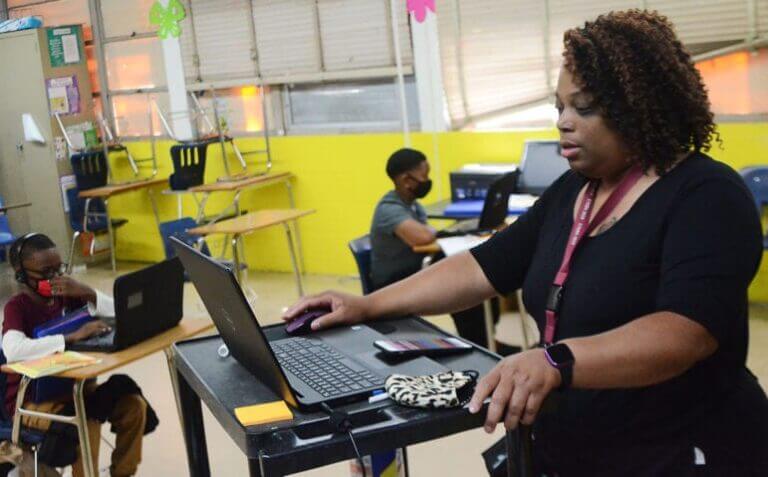

Vickie D. King/Mississippi Today
Jefferson County Elementary School math teacher Tomika Wise instructs students in class and those learning at home via laptops in Fayette.
During any given week in Mississippi, thousands of students who have been exposed to the novel coronavirus are in quarantine. For two weeks, they stay home from school, separated from friends, teachers and even other family members within the house.
Statewide, more than 9,000 students, teachers and staff had to quarantine this past week alone, according to data provided by the Mississippi Department of Health. As a result, parents and teachers must shift how they teach and care for children at home — and some say the impact on student learning and parents’ ability to work is detrimental.
But at least one school district is playing by its own rules when it comes to quarantining. Although state health guidelines recommend that anyone who comes in close contact with an infected person should be quarantined and excluded from the school setting for a full 14 days, the superintendent and school board in the Jackson County School District allow parents to choose whether to quarantine their child after he or she is exposed.

Jackson County School District
Dr. John Strycker, superintendent of the Jackson County School District.
Last week Superintendent John Strycker penned a letter that began: “Mandatory quarantine of healthy students — is it the right decision? Based on data, Jackson County School District says no.”
Strycker, who came to Jackson County in January from Alabama, said he monitors the district’s COVID-19 numbers daily and is making decisions based on what he believes is best for the children. Last month, he made headlines for his decision to end virtual learning in the district except for students with medical conditions.
He cites the statistic that at any one time, positive COVID-19 cases among his students never exceeded .5%. He calculates that number by periodically taking the total number of COVID-19 positive cases in students over a two-week period and dividing that number by the district’s total enrollment.
“When I was (a superintendent) in Michigan, we’d get up to 10% to 15% of our students (in one building) would have the flu. We’d monitor the situation,” he said. “I was told here in Jackson County that even last year, (flu numbers) got as high as 20%.”
“Are we really going to shut down our schools for a quarter of 1%?” he asked.
Strycker also pointed to data showing students who were learning virtually were failing one or more subjects at high rates. Seventy-eight percent of virtual middle schoolers in the A-rated district were failing more than one subject, while 69% of high schoolers were doing the same. In elementary school the number was 38%.
Strycker said the data made it clear to him that students — particularly those in poverty and those who already struggle academically — need to be in school. In addition, the teachers were struggling to keep up with the workload of teaching both in person and virtually.
He went to the school board and told them he had a crisis.
“I was going to lose my good teachers — they were going to burn out,” he said. “You cannot maintain classroom students and online. K-12 is just not set up that way.”
As of early November, 98% of students had returned to full-time, in-person learning in the district.
But data submitted by schools to the state health department shows that since the beginning of the school year, the rate of COVID-19 infections among students in Jackson County School District is more than double the rate in surrounding districts since the beginning of the school year.
When asked what feedback he is receiving from families, staff and community members about not requiring quarantine, Strycker said to look at the numbers.
“Initially (at the beginning of the school year) about 88 to 90% of students came back (to traditional learning), which speaks for itself,” he said. “And we always max out what we’re allowed at football games, the Homecoming parade — I go to something every night.”
When asked about differing quarantine practices among school districts, a spokeswoman for the Mississippi Department of Education said the Mississippi Department of Health and the Office of the Governor lead the state’s pandemic response.
“All school districts are required to follow the directives of these state authorities. The Mississippi Department of Education does not have the legal authority to enforce public health or executive orders in school districts,” spokeswoman Jean Cook said. “Community members who believe their schools are not following MSDH and CDC public health protocols should immediately contact their local school boards. Issues that are not corrected at the local level should be reported to MSDH.”
A request for comment about Jackson County School District from the state health department was not returned by press time. A spokeswoman referred the reporter to a Facebook town hall event.
In many districts, quarantine numbers affect how decisions are made. In Petal School District, the large numbers of quarantined students led the superintendent to transition the high school from a traditional, in-person schedule to hybrid learning in late October.
The week before the school made the transition to the new model, 30% of students at Petal High School were quarantined, said superintendent Matt Dillon.
“We knew going into the school year we were going to have some positive cases (of COVID-19). However, the amount of (students) quarantining has been the most challenging for us,” said Dillon.
He said because of the active and involved student body across his district and at the high school in particular, the number of students quarantining was consistently high, making learning difficult for teachers and students.
“From one moment to the next you don’t know who’s going to be quarantined,” he said. “It’s hard for our teachers to teach not only the traditional students but the quarantined students. Trying to juggle all that is really tough.”
Since transitioning to the new schedule, the quarantine numbers have dropped as intended, said Dillon.
“It (the hybrid schedule) does pose some challenges for our teachers, but they have done a great job adapting to the new schedule,” he said.
For Tatia Kiser, a mother of two children in the Madison County School District who have been quarantined, the process wasn’t easy.
Her daughter, a 9th grader at Rosa Scott, was quarantined midway through the fall semester after a classmate she sat next to tested positive for the virus.
Although both students were wearing masks, the lack of space in the classroom meant they were seated less than six feet apart, her mom said.
“She was very anxious and worried about it because she had been working really hard for good grades,” Kiser said. “With this particular case they did suspend all the deadlines … but still missing classroom time is stressful on the student.”
And not all of her daughter’s teachers offered virtual instruction. Instead, she was given handouts and on some occasions offered one-on-one sessions when she returned to school.
“I will tell you when my daughter went back to school, she was so overwhelmed with the list of missed things. But she did catch up after about five days,” she said.
Kiser was able to keep working because her daughter was old enough to stay home during the daytime, but she said it would’ve been a different situation if her 9-year-old had to quarantine.
But despite the stress, she knows quarantining is necessary.
“I trust Madison County schools are doing the best thing for our kids, and I don’t fault them for anything,” she said. “They’re looking out for the whole student body.”
The post Thousands of Mississippi students quarantine in any given week. One Gulf Coast district is leaving that decision up to parents. appeared first on Mississippi Today.
- Gov. Reeves, Lt. Gov. Hosemann are not lame ducks yet, but perhaps beginning to limp a bit - January 4, 2026
- Wake Forest defeats Mississippi State 43-29 in Duke’s Mayo Bowl - January 3, 2026
- Southern Turnings carves out a place in Wiggins’ revival - January 3, 2026